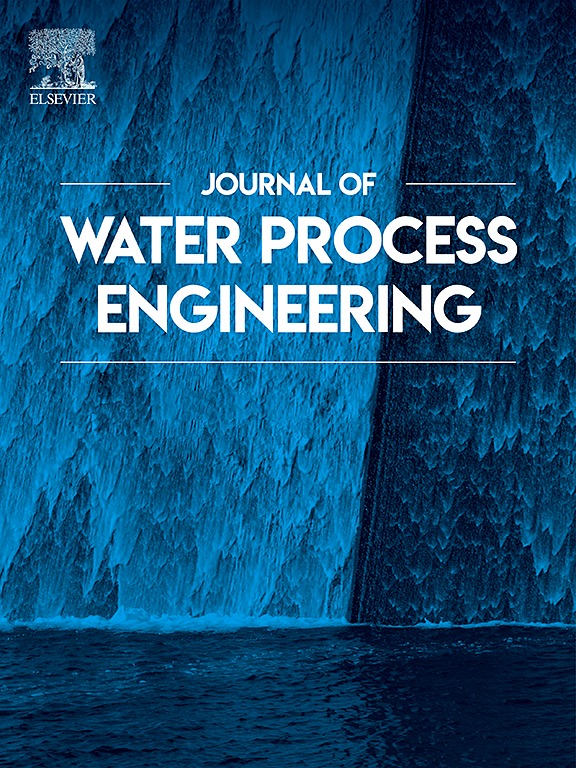Achromobacter sp. JWJ-09 based on methanol co-metabolism efficiently enhanced the degradation of PAHs in coking wastewater and domestic sewage using activated sludge
IF 6.3
2区 工程技术
Q1 ENGINEERING, CHEMICAL
引用次数: 0
Abstract
Naphthalene, anthracene, and pyrene, representative polycyclic aromatic hydrocarbons (PAHs) with two, three, and four aromatic rings, respectively, possess genotoxic, carcinogenic, mutagenic, and teratogenic properties and are common refractory substances in domestic sewage and coking wastewater. Therefore, efficiently degrading PAHs in domestic sewage and coking wastewater is important. Using Achromobacter sp. JWJ-09 and 12 mg·L−1 methanol as the degrading bacterium and co-metabolic substrate, respectively, the removal efficiencies of 100 mg·L−1 naphthalene, 40 mg·L−1 anthracene, and 60 mg·L−1 pyrene reached 76.84 %, 65.77 %, and 72.87 %, respectively, in 120 h. Furthermore, GC–MS analysis showed that the degradation pathway of naphthalene is the protocatechuic acid pathway, whereas that of anthracene and pyrene is the phthalic acid metabolism pathway. To improve the PAHs removal efficiency in biological treatment processes, strain JWJ-09 and methanol were added to the activated sludge. The removal efficiencies of naphthalene, anthracene, pyrene, TN, and COD in domestic sewage increased by 20.81 %, 25.35 % and 37.3 %, 25.13 % and 11.26 %, compared to using activated sludge alone, whereas those in coking wastewater increased by 10.4 %, 11.74 %, 12.03 %, 15.5 % and 15.37 %, respectively. High-throughput sequencing revealed that JWJ-09 and methanol increased the abundance of phyla Actinobacteriota and Chloroflexi in domestic sewage activated sludge by 23.37 %, 10.06 %, and enriched bacterial genera. The abundances of Acidobacteriota, Chloroflexi and the genus norank_ f_ _ Blastocatellacea in activated sludge for the PAHs degradation in coking wastewater increased by 25.31 %, 3.49 % and 25.04 %, respectively. In conclusion, JWJ-09 and methanol co-metabolism enhanced activated sludge can treat domestic sewage and coking wastewater containing PAHs.

基于甲醇共代谢的Achromobacter sp. JWJ-09利用活性污泥有效地增强了焦化废水和生活污水中PAHs的降解能力
萘、蒽、芘是具有代表性的2环、3环、4环多环芳烃,具有遗传毒性、致癌性、诱变性和致畸性,是生活污水和焦化废水中常见的难处理物质。因此,高效降解生活污水和焦化废水中的多环芳烃具有重要意义。以Achromobacter sp. JWJ-09和12 mg·L−1甲醇为降解菌和共代谢底物,在120 h内对100 mg·L−1萘、40 mg·L−1蒽和60 mg·L−1芘的去除率分别达到76.84%、65.77%和72.87%。此外,GC-MS分析表明,萘的降解途径为原儿茶酸途径,而蒽和芘的降解途径为邻苯二甲酸代谢途径。为提高生物处理工艺对多环芳烃的去除效率,在活性污泥中添加菌株JWJ-09和甲醇。与单独使用活性污泥相比,生活污水中萘、蒽、芘、TN和COD的去除率分别提高了20.81%、25.35%和37.3%、25.13%和11.26%,焦化废水的去除率分别提高了10.4%、11.74%、12.03%、15.5%和15.37%。高通量测序结果显示,JWJ-09和甲醇可使生活污水活性污泥中放线菌门和氯菌门的丰度分别提高23.37%和10.06%,并可丰富细菌属。对焦化废水中多环芳烃的降解活性污泥中Acidobacteriota、Chloroflexi和norank_ f_ Blastocatellacea的丰度分别提高了25.31%、3.49%和25.04%。综上所述,JWJ-09与甲醇共代谢强化活性污泥可处理含多环芳烃的生活污水和焦化废水。
本文章由计算机程序翻译,如有差异,请以英文原文为准。
求助全文
约1分钟内获得全文
求助全文
来源期刊

Journal of water process engineering
Biochemistry, Genetics and Molecular Biology-Biotechnology
CiteScore
10.70
自引率
8.60%
发文量
846
审稿时长
24 days
期刊介绍:
The Journal of Water Process Engineering aims to publish refereed, high-quality research papers with significant novelty and impact in all areas of the engineering of water and wastewater processing . Papers on advanced and novel treatment processes and technologies are particularly welcome. The Journal considers papers in areas such as nanotechnology and biotechnology applications in water, novel oxidation and separation processes, membrane processes (except those for desalination) , catalytic processes for the removal of water contaminants, sustainable processes, water reuse and recycling, water use and wastewater minimization, integrated/hybrid technology, process modeling of water treatment and novel treatment processes. Submissions on the subject of adsorbents, including standard measurements of adsorption kinetics and equilibrium will only be considered if there is a genuine case for novelty and contribution, for example highly novel, sustainable adsorbents and their use: papers on activated carbon-type materials derived from natural matter, or surfactant-modified clays and related minerals, would not fulfil this criterion. The Journal particularly welcomes contributions involving environmentally, economically and socially sustainable technology for water treatment, including those which are energy-efficient, with minimal or no chemical consumption, and capable of water recycling and reuse that minimizes the direct disposal of wastewater to the aquatic environment. Papers that describe novel ideas for solving issues related to water quality and availability are also welcome, as are those that show the transfer of techniques from other disciplines. The Journal will consider papers dealing with processes for various water matrices including drinking water (except desalination), domestic, urban and industrial wastewaters, in addition to their residues. It is expected that the journal will be of particular relevance to chemical and process engineers working in the field. The Journal welcomes Full Text papers, Short Communications, State-of-the-Art Reviews and Letters to Editors and Case Studies
 求助内容:
求助内容: 应助结果提醒方式:
应助结果提醒方式:


